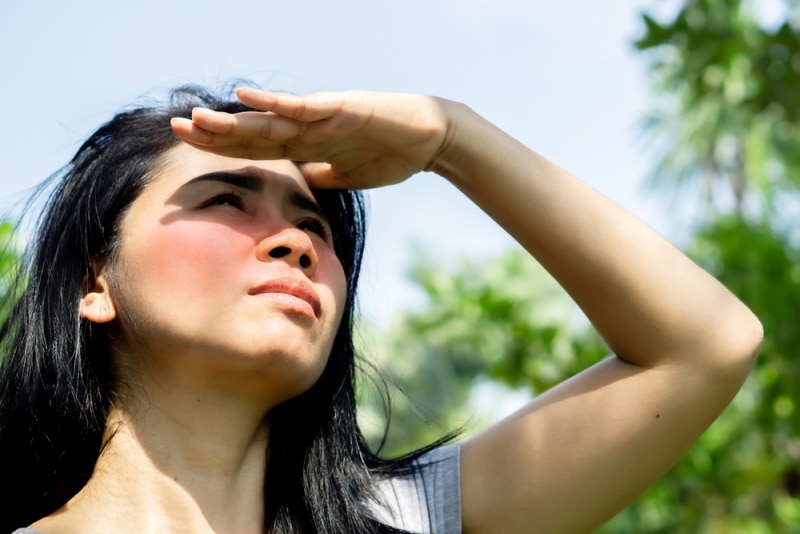Can Humans See Ultraviolet Light? The Surprising Answer!
Last Updated on

Your first association with ultraviolet (UV) light is undoubtedly its effects on your skin. Those are certainly visible when you get a sunburn. However, you may wonder if humans can see wavelengths of this spectrum. The short answer is no, although there is evidence that some people can. Suffice to say that humans are unique in their ability not to see UV light.

Defining Light
To put this question in perspective, we must begin with defining light. Essentially, it’s one form of electromagnetic radiation (EMR). Other familiar types¹ include microwaves and radio waves. These exist on the high end of the spectrum. The low end consists of UV light, gamma-rays, and X-rays. Between these two poles exists the range of visible light.
Scientists define and classify these different types by their wavelength. For example, radio waves are 10 millimeters in length, whereas UV light comes in between 100–400 nanometers. The wavelengths in the visible light spectrum are from 400–780 nanometers. The proximity of these figures is a clue to why some people can see UV light.
UV Light

The range of UV light is relatively large. Therefore, scientists further categorize it into various types based on its wavelength. This classification helps to explain why it has both beneficial and harmful effects. They are as follows:
- UVA or near UV: 315–400 nanometers
- UV-B or middle UV: 280–315 nanometers
- UV-C or far UV: 180–280 nanometers
It’s essential to realize the complexity of UV light to understand why humans lack this ability. UVA makes up about 95% of this EMR that reaches the Earth’s surface. The remainder is UVB. Our atmosphere absorbs UVC, which is a good thing as it’s the most harmful. However, that’s not to say that the others are all good.
UVA and UVB play a role in some cancers¹. Excessive exposure to the former can cause premature skin aging. The latter causes sunburns. The National Weather Service¹ (NWS) publishes its Ultraviolet Index to inform you about your exposure risk so that you can take the necessary precautions. Ironically, UVB is also vital in the protection against some cancers. It is also critical for supplying vitamin D.
By spending some time outside, you allow your body to absorb some UVB, which can, in turn, use previtamin D3¹ inside you to convert it to a usable form. About 15 minutes of exposure a few times a week¹ will ensure that you’re the correct RDA of this nutrient. Surprisingly, if you live above 37 degrees north latitude, you may not get enough UVB exposure, necessitating a vitamin D supplement.
Sources of UV Light
Even if you can’t see UV light, it doesn’t mean it’s not around you. For example, black lights emit UVA, as do tanning booths. Halogen lamps, fluorescent tubes, and UV LEDs all produce it in some form. If you like to get a jumpstart on your gardening, you might use a plant light to grow vegetables inside before the planting season.
Reasons Humans Can’t See UV Light—Usually

We know that UV light has a good and bad side to it. You may wonder why we can’t see it if it could potentially harm us. The reason is that if you could see it, it may damage your retina and increase your risk of blindness. That’s why you must wear special glasses to view a solar eclipse. The lens in each of your eyes filters out UV light to protect the rest of the structures. That brings us to the exceptions.
Over 50%¹ of people develop age-related cataracts by the time they reach 80 years old. It can cause blurry vision and distort colors. The surgery correcting your vision involves removing your lens and replacing it with an artificial one. Some individuals develop a condition called pseudophakia¹. An effect is the ability to see UV light. Blue light receptors can see it more readily than the color.
An interesting side note of pseudophakia involves the Impressionist artist Claude Monet¹. The painter had cataracts later in life. Scientists speculate that he developed this condition after surgery to remove his lens. The evidence is his changing palette and the art he created afterward. Shades of blue became more prominent because he may have been able to see UV light.
Organisms That Can See It
Evolution didn’t dismiss the adaptation to see UV light in other organisms. It has played a vital role in the survival of many animals. For example, mice can see the UV light absorbed by their urine trails identifying their territories. Consequently, predators, such as many raptor species, also have that ability. Scientists have documented it in other animals, such as honeybees and some reptiles.
Humans don’t usually see UV light because it doesn’t offer any evolutionary benefits. Nevertheless, researchers have theorized that this has been a possible key to the origin of life¹ on our planet, particularly with the development of ribonucleic acid (RNA). This chemical compound directs the production of proteins contained in an organism’s DNA. UV light might have provided the vital spark.

Summing Up
UV light may have been critical for the existence of all life on Earth. While many organisms can see it, others, like humans, cannot see this invisible world all around us. The lens of our eyes keeps us from visualizing it, for the most part. Those with this ability can enjoy another spectrum of light and color, adding another dimension to their worlds.
Featured Image Credit: Doucefleur, Shutterstock
About the Author Chris Dinesen Rogers
Chris has been writing since 2009 on a variety of topics. Her motto with all of her writing is “science-based writing nurtured by education and critical thinking.” Chris specializes in science topics and has a special love for health and environmental topics, and animals of all shapes and sizes.
Related Articles:
Can You Use Binoculars to Look At Stars? How to Choose the Right Pair
How to Clean a Refractor Telescope: Step-by-Step Guide
How to Clean a Telescope Eyepiece: Step-by-Step Guide
How to Clean a Rifle Scope: 8 Expert Tips
Monocular vs Telescope: Differences Explained (With Pictures)
What Is a Monocular Used For? 8 Common Functions
How to Clean a Telescope Mirror: 8 Expert Tips
Brightfield vs Phase Contrast Microscopy: The Differences Explained
